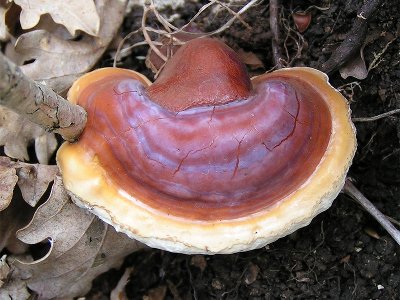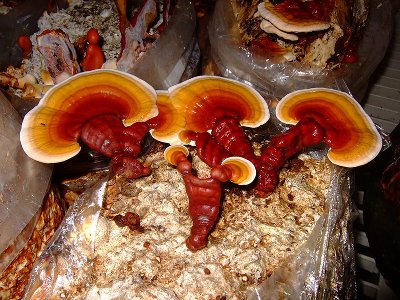Reishi Mushroom
 Common Names: reishi mushroom, lingzhi mushroom, ling chi mushroom, varnished conk. The Chinese name, Lingzhi, means ‘tree of life’, and the Japanese name, reishi, means ‘divine’ or ‘spiritual’.
Common Names: reishi mushroom, lingzhi mushroom, ling chi mushroom, varnished conk. The Chinese name, Lingzhi, means ‘tree of life’, and the Japanese name, reishi, means ‘divine’ or ‘spiritual’.
Scientific Name: Ganoderma Lucidum
Climate: Tropical, sub-tropical and moderate
Plant Description: This is a decomposer and/or parasite. It is white when it begins to grow but then turns yellow and finally a shiny reddish brown when it is mature. The underside remains white. The size varies from two to 35 centimeters wide and four to eight centimeters thick. It has spores on the underside of the mushroom and not in gills, so it is a polypore mushroom. It is found in many countries and grows on a variety of trees, but it prefers hardwoods, such as oak, and warmer climates.
Cultivation: The reishi mushroom is suited to food forests. There is not much small-scale production but there is a lot of large-scale, commercial production as this mushroom is very popular in traditional Chinese medicine.
If you grow reishi on logs, the logs need to be left for about two weeks so that the natural defenses of the tree reduce. Storing them near the ground and in the shade prevents them from drying out. Ideally, they should receive rainfall. The logs should not be left for more than six weeks. Next you need to drill holes in the log, place spawn in the holes, and seal the holes with wax. The logs are then placed on the ground in the shade, in warm, humid conditions. It is very important to maintain the logs moist at this stage. They take about a year to fruit. To harvest, cut the mushroom at the base of the stem attached to the log.
Reishi can also be grown on the sawdust of oak, mango and coconut trees. The sawdust is mixed with about 20% wheat bran and this needs to have about 65% moisture. This substrate is placed in sterilized plastic bags. Spawning occurs best in dark rooms at about 30 degrees centigrade. When the top layer is completely covered in white, which takes about 25 days, the bag is cut at the level of the substrate to allow pinning to occur. When the mushrooms are mature, they are harvested by plucking at the root.
They can be dried or refrigerated for several weeks.
 Uses: The reishi mushroom is one of the most commonly used mushrooms in traditional Asian medicine and is hugely popular in China and Japan. Although they can be eaten fresh, they are used in their dried and powdered forms for medicinal purposes.
Uses: The reishi mushroom is one of the most commonly used mushrooms in traditional Asian medicine and is hugely popular in China and Japan. Although they can be eaten fresh, they are used in their dried and powdered forms for medicinal purposes.
Studies show that reishi has effects on the white blood cells, which are an important part of the immune system, and can help fight infection and certain types of cancer. However, these effects may be limited to ill patients as some studies found little or no effects from reishi on healthy people. There are indications that reishi can reduce fatigue, anxiety, and depression. Most research has shown that it does not improve cholesterol, antioxidants or blood sugar.
Although reishi is a very popular medicinal plant, some have questioned it’s safety. There is conflicting evidence as to its effects on the liver and kidneys. There is some evidence that it may cause upset stomach. These side effects that have been noted my be due to the form in which it is taken and the dosage.
When the mushroom is consumed, doses can range from 25 to 100 grams. Extract doses are usually ten times lower ranging from about 1.5 to 10 grams. per day. As some doubts remain about the safety of reishi, it is probably best avoided by pregnant women, breastfeeding mothers, those with blood disorders, and those with low blood pressure.
Possible Problems: If you are using logs to grow the mushroom, as with the cultivation of other mushrooms, it is important that they are dried first. They should be kept separate from firewood to avoid pests and diseases. If they develop mould, they need to be moved around to ensure better air circulation. If they become too infested, they need to be replaced. If the logs can become too dry, they should be sprayed with water.
References:
http://tcpermaculture.com/site/2014/02/20/reishi-ling-chi-mushroom/
https://www.fieldforest.net/product/reishi-on-logs-instruction-sheet/instruction-sheets
http://nrcmushroom.org/Folder_Ganoderma.pdf
https://www.healthline.com/nutrition/reishi-mushroom-benefits#section2
https://morningchores.com/growing-lions-mane-mushrooms/
En español: Hongo reishi
